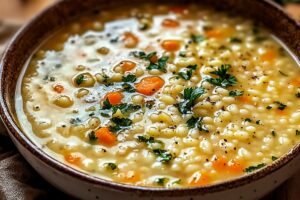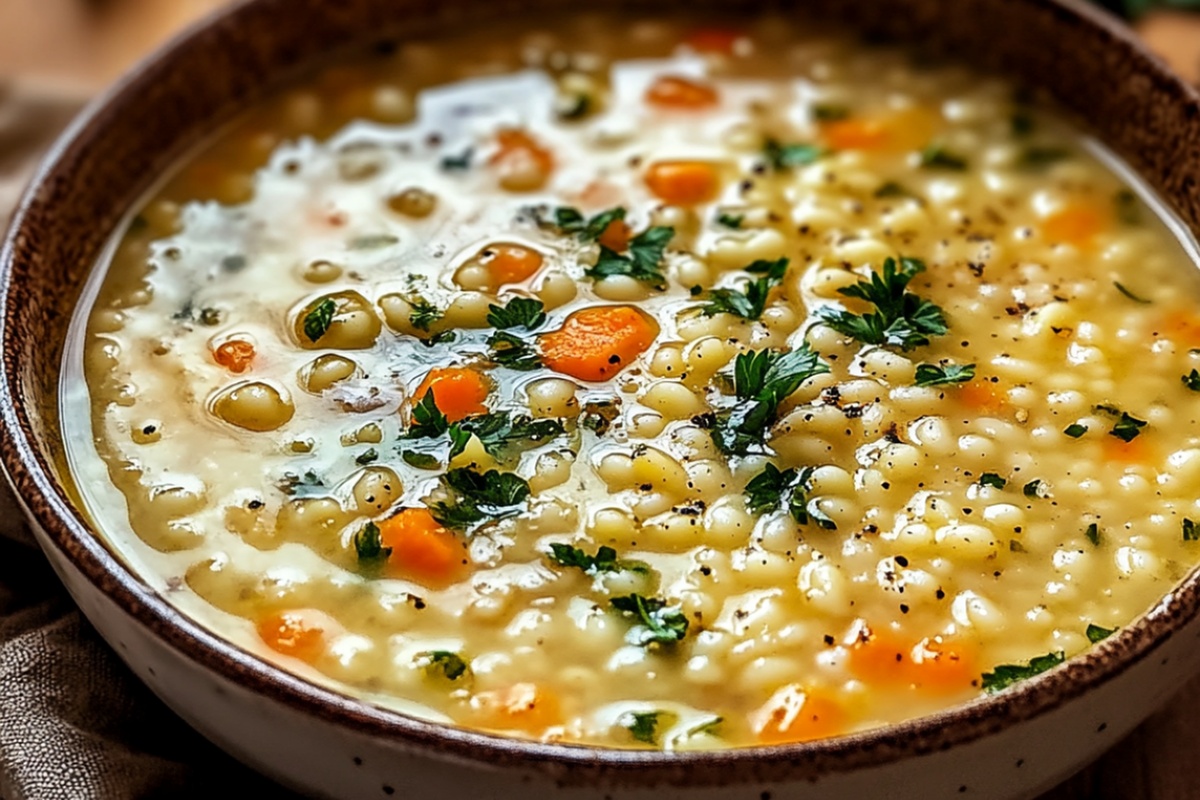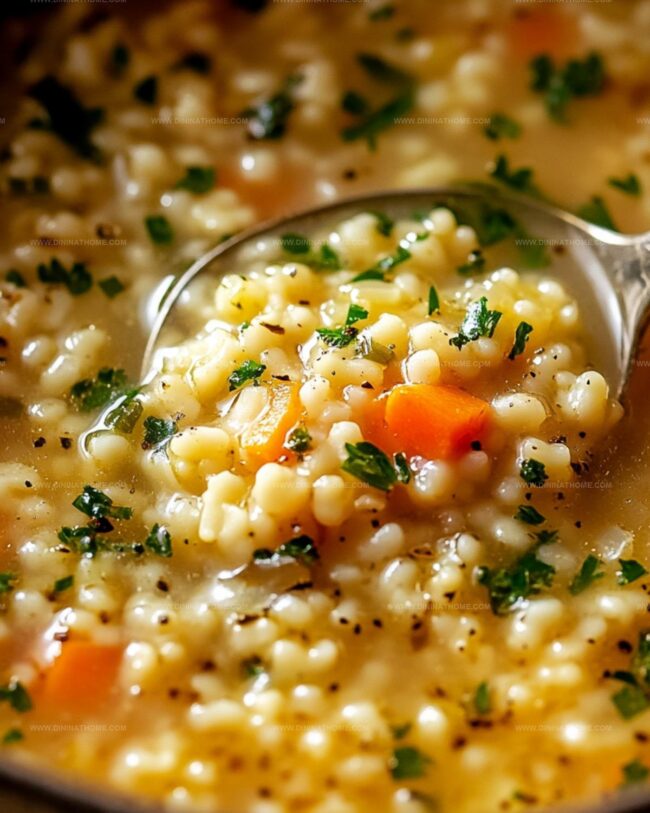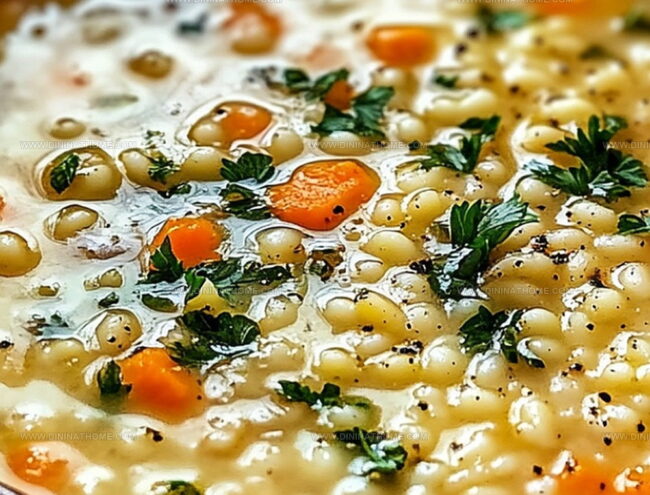Cozy Homemade Pastina Soup Recipe: Comfort in a Bowl
Warming memories of childhood comfort swirl through this delicate pastina soup that connects generations with its simple magic.
Grandmothers across Italian kitchens have whispered secrets into each tiny pasta pearl.
Delicate stars float in a silky broth, promising pure nourishment and gentle healing.
Mothers learned this recipe from their own maternal lineages, passing down traditions through steaming bowls.
Soft, tender pasta dissolves like whispers, creating a liquid embrace that soothes and restores.
Tender ingredients blend seamlessly, crafting a moment of pure culinary comfort.
Comfort in a Bowl: Pastina Soup
What Makes Up Pastina Soup
Main Ingredients:Finishing Touches:Pastina Soup Instructions the Classic Way
Step 1: Prepare Aromatic Base
Warm up a spacious pot over medium flame.
Splash in a generous glug of olive oil.
Toss in these delightful ingredients:Sizzle and dance these veggies around for 5-7 minutes until they’re soft, golden, and broadcasting mouthwatering aromas throughout your kitchen.
Step 2: Build Flavor Foundation
Pour in chicken or vegetable broth with enthusiasm.
Drop in a Parmesan rind for extra depth if you’re feeling fancy.
Crank up the heat to bring everything to a robust boil.
Once bubbling, dial down the temperature and let the liquid whisper and simmer for 15-20 minutes, allowing flavors to mingle and get acquainted.
Step 3: Welcome Tiny Pasta
Introduce pastina into the warm broth landscape.
Stir gently and cook according to package guidance, typically 6-8 minutes.
Keep an eye on those adorable little pasta pearls, giving occasional stirs to prevent any clingy behavior.
Step 4: Final Flourish
Bid farewell to the Parmesan rind.
Season with salt and black pepper, tailoring to your taste preferences.
Ladle this liquid comfort into waiting bowls.
Crown your creation with:Serve piping hot and prepare for pure culinary bliss.
Soothing Prep Tips for Homemade Pastina Soup
Save Pastina Soup Properly
Serving Suggestions for Pastina Soup
Pastina Soup Comforting Additions
FAQs
Pastina is a tiny, star-shaped pasta traditionally used in Italian soups and broths, especially for children and when someone is feeling unwell. It’s smaller than most pasta shapes and cooks quickly.
Yes, simply use vegetable broth instead of chicken broth. You can also omit the Parmesan rind or use a vegetarian Parmesan-style cheese alternative to keep the flavor profile.
Absolutely! It’s a nutrient-rich soup packed with vegetables, protein from broth, and provides comfort and warmth. The combination of vegetables and pasta makes it a balanced, nourishing meal that’s especially good during cold seasons or when recovering from illness.
If pastina isn’t available, you can substitute with other small pasta shapes like orzo, stelline (small stars), or even broken vermicelli. The key is using a tiny pasta that cooks quickly and absorbs the soup’s flavors.
Print
Pastina Soup Recipe
- Total Time: 40 minutes
- Yield: 4 1x
Description
Comforting Italian pastina soup brings warmth and nostalgia to your kitchen, embracing childhood memories with its delicate pasta and rich broth. Simple ingredients combine effortlessly, creating a soulful meal you’ll crave during chilly evenings.
Ingredients
main ingredients:
- 6 cups (1.4 liters) low-sodium chicken or vegetable broth
- 1 cup (240 milliliters) pastina (tiny star-shaped pasta or other small pasta shapes)
vegetables:
- 1 medium yellow onion, chopped
- 2 carrots, peeled and chopped
- 2 celery stalks, chopped
- 4 garlic cloves, minced
seasonings and garnish:
- 1 Parmesan rind (optional)
- Salt, to taste
- Black pepper, to taste
- Fresh parsley, chopped
- Grated Parmesan cheese
- Extra virgin olive oil
Instructions
- Prepare a large pot and warm it over medium heat, drizzling olive oil to create a flavorful base.
- Gently introduce chopped onions, carrots, celery, and minced garlic, sautéing them until they become translucent and release their aromatic essence, approximately 5-7 minutes.
- Pour the selected broth into the vegetable mixture, adding the Parmesan rind to infuse depth and richness.
- Elevate the heat to trigger boiling, then immediately reduce to a gentle simmer, allowing the ingredients to harmonize and develop complex flavors for 15-20 minutes.
- Carefully introduce pastina into the simmering liquid, stirring periodically to prevent clumping and ensure even cooking.
- Monitor the pasta’s tenderness, typically requiring 6-8 minutes of cooking until it reaches a soft, delicate consistency.
- Extract and discard the Parmesan rind, then calibrate the soup’s flavor profile with strategic salt and pepper seasoning.
- Transfer the steaming soup into serving bowls, creating an elegant presentation by garnishing with freshly chopped parsley, a delicate sprinkle of grated Parmesan, and a refined drizzle of extra virgin olive oil.
Notes
- Customize the soup base by swapping chicken broth with vegetable or bone broth for different flavor profiles and dietary needs.
- Enhance nutrition by adding shredded rotisserie chicken or diced cooked protein like white beans for extra substance.
- Choose smaller pasta varieties like orzo or stelline if pastina is unavailable, maintaining the soup’s delicate texture and kid-friendly appeal.
- Easily make this recipe vegetarian by using vegetable broth and omitting Parmesan rind, ensuring versatility for various dietary preferences.
- Prep Time: 10 minutes
- Cook Time: 30 minutes
- Category: Lunch, Dinner, Snacks
- Method: Sautéing
- Cuisine: Italian
Nutrition
- Serving Size: 4
- Calories: 180
- Sugar: 2 g
- Sodium: 350 mg
- Fat: 4 g
- Saturated Fat: 1 g
- Unsaturated Fat: 3 g
- Trans Fat: 0 g
- Carbohydrates: 30 g
- Fiber: 2 g
- Protein: 7 g
- Cholesterol: 5 mg





James Walker
Lead Recipe Developer & Culinary Educator
Expertise
Southern Cuisine & Farm-to-Table Cooking, Recipe Development & Testing, Culinary Education & Instruction
Education
School: Auguste Escoffier School of Culinary Arts
Program: Diploma in Culinary Arts and Operations
Focus: Comprehensive training in classical and modern culinary techniques, kitchen operations, and farm-to-table practices.
James didn’t learn cooking from a TV show, he learned it from busy kitchens, family gatherings, and long afternoons spent testing recipes the hard way.
After training at the Auguste Escoffier School of Culinary Arts, he brought his love for real, down-to-earth food to every dish he makes.
At Dining At Home, James loves building recipes that feel familiar but still have something special, like adding a twist to a classic or making a slow Sunday dinner feel brand new.
When he’s not in the kitchen, you’ll probably find him swapping garden tips at the farmers’ market or teaching his daughter how to flip pancakes without a mess (almost).